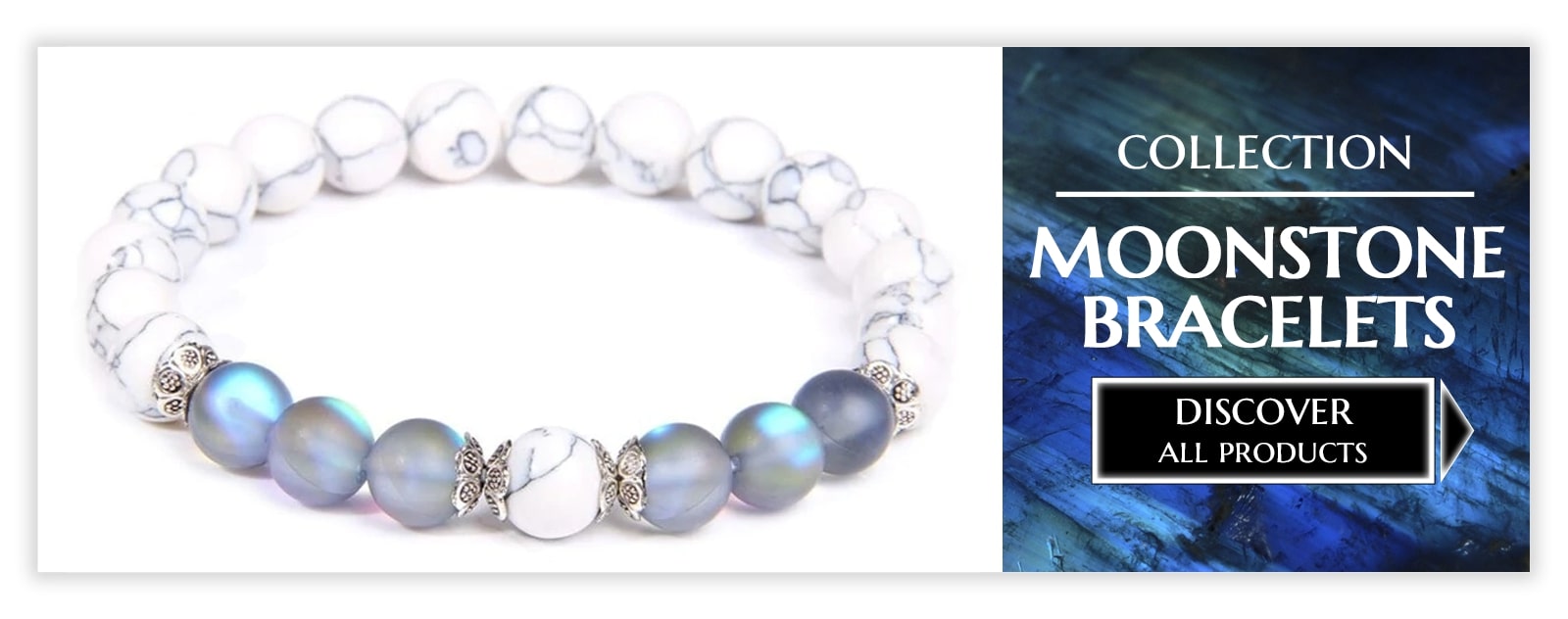
Moonstone june birthstone
Birthstone of the month of June, the moonstone brings you all the happiness of this stone, mainly related to love for the family or for the child. This stone acts on the astral and mental bodies while allowing to regulate the emotions. But the moonstone birthstone of June is not the only one, the month of June is the only month where there are several birthstones, the moonstone shares this title with the cultured pearl and alexandrite, we will also see the qualities of these birthstones of June.
Meaning of the moonstone June birthstone

This stone of June represents the harmony of love. As early as the Gallo-Roman Empire, it was thought that moonstone had the same powers as the star from which it came. Its reflections were considered to change with the phases of the moon. It was used in the Middle Ages by nursing mothers to increase lactation. The breasts of women were then rubbed with a white moonstone. In mythology, it was associated with femininity, maternity and the deities representing them. It is a stone of female sensuality and eroticism.
Benefits of the moonstone, birthstone of June

Also called Adular stone, the moonstone is the symbol of innocence and everything related to childhood. It is used nowadays in Crystal Healing in the energetic care of the third eye and summit chakras. The moonstone stimulates imagination, intuition, gentleness, but also decision making. Indeed, it allows with firmness and softness to find the courage to choose its own way. It is an excellent stone for meditation and for working on the emotional balance between the mental body and the astral body. It is also known to induce premonitory dreams.
Within the couple, it calls for harmony and reconciliation, thanks to its role in the management of emotions. It allows to develop a sharp artistic sense by increasing the sensitivity and the inventiveness. Simplicity, tenderness and poetry are the key words linked to this stone with bluish reflections. Stone of purification and hope, the moonstone will help to pass the difficult moments of the life.
Chakras associated with the June stone, the moonstone
Symbol of femininity, this stone of the month of June helps to fight against infertility. It is associated with the sacral chakra on which it will be placed about ten minutes a day. It will also be necessary to place it on the ovaries in the same way. During the breast feeding, we position it between the breasts on the skin to stimulate the rise of milk. It will be necessary however to take care not to use it during the full Moon.
The moonstone is also advised in the problems of thyroid. Put it on the heart chakra, as a pendant for example to stimulate this organ. It can also be used in elixir to drink. Finally, it has an action in case of eye problems. The stone will have to soak in water during 1 hour in the light of the Moon, to be then applied on the eyes thanks to a compress.
Astrological signs associated with moonstone
The moonstone is related to the natives of the month of June and the astrological sign of Cancer. If the cancer is a hypersensitive person, this stone is ideal to help him in the management of his emotions. It will develop their intuition with accuracy. It will help Cancers to develop their already present qualities, instinct, loyalty, perseverance, and will bring them all the protection they so much need. The Cancer native is also quite homey and routine, it is a framework that makes him secure. They don't like to go out of their way and their family has a central place for them. They can quickly become jealous of their loved one.

Cancers also hold grudges, although they are very good at hiding this flaw. Indeed, they prefer to avoid conflicts rather than face them. Gifted with a strong intelligence and an ability to coax, he can be very authoritarian. The moonstone will bring him the softness he needs.
How many birthstones does june have

Unlike the other months of the year, June has three birthstones. Succumb to the magical color changes of alexandrite depending on the light. Moonstone is distinguished by its adularescence, an optical effect that produces a glittering reflection across its surface. As for the cultured pearl, it is a calcareous concretion produced by a mollusk and not extracted from a deposit. It has the curious characteristic of being the result of a "biomineralization". We have already explained everything you need to know about the moonstone birthstone of June, let's see together the qualities of the two other birthstones of June which are the cultured stone and the alexandrite.
Cultured Pearl

Cultured pearls known as the "Queen of Jewels" are listed as a birthstone for the month of June and as a commemorative stone for the thirteenth and thirtieth wedding anniversary. It symbolizes health, peace, wealth and longevity. Pearls have been loved by people since ancient times and bring best wishes to those born during this month.
Cultured pearls are the only organic gemstone that is produced by living organisms. They are mainly produced in mollusks such as saltwater shellfish and freshwater mussels, which, due to the stimulation of foreign substances, create a mixture of calcium carbonate and hard proteins.
This means that the nacre or "mother of pearl" envelops the irritant like a protective shell, which then turns into a pearl. Over time, the nacre thickens and the pearl becomes more valuable. According to the genesis, pearls are divided into 2 types: natural and cultured. Nowadays, the vast majority of pearls on the market are cultured pearls.
- Natural Pearls
Natural pearls are produced without human intervention, usually with a core that comes from the environment, such as gravel. Although pearls have been used as decoration for thousands of years, natural pearls are extremely rare and represent only a small percentage of the total number of pearls on the market.
- Cultured Pearls
Pearls formed by manual intervention. To grow cultured pearls, the grower implants individual mantle membranes into the mollusks (usually for freshwater aquaculture) or with a mother-of-pearl (all marine cultures). As a result, the mollusks secrete a pearly nacre to envelop the irritant, which is consistent with natural pearl formation.
Alexandrite of June

Because of its color-changing effect from green in sunlight to red in candlelight and incandescent lamps, alexandrite has been hailed by many poets as "an emerald by day and a ruby by night." It is said that alexandrite was first found in an emerald mine in the Urals, Russia, in 1830. The miners dedicated this gem to Prince Alexander II on his 21st birthday.
As a birthstone for June, alexandrite promotes emotional well-being by increasing confidence, self-esteem and ultimately making the person happy. It also symbolizes luck, good fortune, prosperity and longevity. In daylight, its color is usually gray-green, light yellow-green or blue-green; but under incandescent light sources, it usually looks brown or purplish red. This is why alexandrites are commonly called "emeralds by day, rubies by night".
Alexandrite contains a small amount of chromium, which makes it the most powerful in transmitting green light, the second most powerful in transmitting red light, and it absorbs all other light very strongly. Therefore, during the day, under sunlight, the stone transmits the most green light, which makes it appear green. When illuminated by approximately white light, similar to daylight, it also appears blue. But at night, when we use candles, oil lamps or red-rich tungsten filament lamps, the stone transmits the most red light, making it appear red. Alexandrite's strong and obvious discoloration makes it an excellent treasure.





